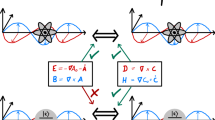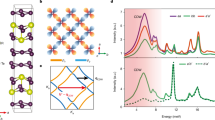Abstract
In quantum electrodynamics, the choice of gauge influences the form of light–matter interactions. However, gauge invariance implies that all physical results should be independent of this formal choice. The Rabi model, a widespread description for the dipolar coupling between a two-level atom and a quantized electromagnetic field, seemingly violates this principle in the presence of ultrastrong light–matter coupling, a regime that is now experimentally accessible in many physical systems. This failure is attributed to the finite-level truncation of the matter system, an approximation that enters the derivation of the Rabi model. Here, we identify the source of gauge violation and provide a general method for the derivation of light–matter Hamiltonians in truncated Hilbert spaces that produces gauge-invariant physical results, even for extreme light–matter interaction regimes. This is achieved by compensating the non-localities introduced in the construction of the effective Hamiltonians. The resulting quantum Rabi Hamiltonian in the Coulomb gauge differs significantly in form from the standard one, but provides the same physical results obtained by using the dipole gauge. These results shed light on gauge invariance in the non-perturbative and extreme-interaction regimes, and solve long-lasting controversies arising from gauge ambiguities in the quantum Rabi and Dicke models.
This is a preview of subscription content, access via your institution
Access options
Access Nature and 54 other Nature Portfolio journals
Get Nature+, our best-value online-access subscription
$29.99 / 30 days
cancel any time
Subscribe to this journal
Receive 12 print issues and online access
$209.00 per year
only $17.42 per issue
Buy this article
- Purchase on Springer Link
- Instant access to full article PDF
Prices may be subject to local taxes which are calculated during checkout


Similar content being viewed by others
Data availability
The data that support the plots within this paper and other findings of this study are available from the corresponding author upon reasonable request.
References
Kockum, A. F., Miranowicz, A., Liberato, S. D., Savasta, S. & Nori, F. Ultrastrong coupling between light and matter. Nat. Rev. Phys. 1, 19–40 (2019).
Forn-Díaz, P., Lamata, L., Rico, E., Kono, J. & Solano, E. Ultrastrong coupling regimes of light–matter interaction. Preprint at https://arxiv.org/abs/1804.09275 (2018).
Yoshihara, F. et al. Superconducting qubit–oscillator circuit beyond the ultrastrong-coupling regime. Nat. Phys. 13, 44–47 (2017).
Yoshihara, F. et al. Inversion of qubit energy levels in qubit-oscillator circuits in the deep-strong-coupling regime. Phys. Rev. Lett. 120, 183601 (2018).
Ashhab, S. & Nori, F. Qubit-oscillator systems in the ultrastrong-coupling regime and their potential for preparing nonclassical states. Phys. Rev. A 81, 042311 (2010).
Casanova, J., Romero, G., Lizuain, I., García-Ripoll, J. J. & Solano, E. Deep strong coupling regime of the Jaynes–Cummings model. Phys. Rev. Lett. 105, 263603 (2010).
Niemczyk, T. et al. Circuit quantum electrodynamics in the ultrastrong-coupling regime. Nat. Phys. 6, 772–776 (2010).
Zaks, B. et al. THz-driven quantum wells: coulomb interactions and Stark shifts in the ultrastrong coupling regime. New J. Phys. 13, 083009 (2011).
Stassi, R., Ridolfo, A., Di Stefano, O., Hartmann, M. J. & Savasta, S. Spontaneous conversion from virtual to real photons in the ultrastrong-coupling regime. Phys. Rev. Lett. 110, 243601 (2013).
Cirio, M., De Liberato, S., Lambert, N. & Nori, F. Ground state electroluminescence. Phys. Rev. Lett. 116, 113601 (2016).
De Liberato, S., Gerace, D., Carusotto, I. & Ciuti, C. Extracavity quantum vacuum radiation from a single qubit. Phys. Rev. A 80, 053810 (2009).
De Liberato, S. Light–matter decoupling in the deep strong coupling regime: the breakdown of the Purcell effect. Phys. Rev. Lett. 112, 016401 (2014).
Garziano, L. et al. Multiphoton quantum Rabi oscillations in ultrastrong cavity QED. Phys. Rev. A 92, 063830 (2015).
Garziano, L. et al. One photon can simultaneously excite two or more atoms. Phys. Rev. Lett. 117, 043601 (2016).
Garziano, L., Ridolfo, A., De Liberato, S. & Savasta, S. Cavity QED in the ultrastrong coupling regime: photon bunching from the emission of individual dressed qubits. ACS Photon. 4, 2345–2351 (2017).
Di Stefano, O. et al. Feynman-diagrams approach to the quantum Rabi model for ultrastrong cavity QED: stimulated emission and reabsorption of virtual particles dressing a physical excitation. New J. Phys. 19, 053010 (2017).
Kockum, A. F., Miranowicz, A., Macrì, V., Savasta, S. & Nori, F. Deterministic quantum nonlinear optics with single atoms and virtual photons. Phys. Rev. A 95, 063849 (2017).
Felicetti, S., Rossatto, D. Z., Rico, E., Solano, E. & Forn-Daz, P. Two-photon quantum Rabi model with superconducting circuits. Phys. Rev. A 97, 013851 (2018).
Nataf, P. & Ciuti, C. Vacuum degeneracy of a circuit QED system in the ultrastrong coupling regime. Phys. Rev. Lett. 104, 023601 (2010).
Nataf, P. & Ciuti, C. Protected quantum computation with multiple resonators in ultrastrong coupling circuit QED. Phys. Rev. Lett. 107, 190402 (2011).
Romero, G., Ballester, D., Wang, Y. M., Scarani, V. & Solano, E. Ultrafast quantum gates in circuit QED. Phys. Rev. Lett. 108, 120501 (2012).
Kyaw, T. H., Felicetti, S., Romero, G., Solano, E. & Kwek, L.-C. Scalable quantum memory in the ultrastrong coupling regime. Sci. Rep. 5, 8621 (2015).
Wang, Y., Zhang, J., Wu, C., You, J. Q. & Romero, G. Holonomic quantum computation in the ultrastrong-coupling regime of circuit QED. Phys. Rev. A 94, 012328 (2016).
Stassi, R. et al. Quantum nonlinear optics without photons. Phys. Rev. A 96, 023818 (2017).
Kockum, A. F., Macrì, V., Garziano, L., Savasta, S. & Nori, F. Frequency conversion in ultrastrong cavity QED. Sci. Rep. 7, 5313 (2017).
Armata, F., Calajo, G., Jaako, T., Kim, M. S. & Rabl, P. Harvesting multiqubit entanglement from ultrastrong interactions in circuit quantum electrodynamics. Phys. Rev. Lett. 119, 183602 (2017).
Babiker, M. & Loudon, R. Derivation of the Power–Zienau–Woolley Hamiltonian in quantum electrodynamics by gauge transformation. Proc. R. Soc. Lond. A 385, 439–460 (1983).
Maggiore, M. A Modern Introduction to Quantum Field Theory (Oxford Series in Physics no. 12, Oxford University Press, 2005).
Lamb, W. E. Fine structure of the hydrogen atom. III. Phys. Rev. 85, 259–276 (1952).
Lamb, W. E., Schlicher, R. R. & Scully, M. O. Matter–field interaction in atomic physics and quantum optics. Phys. Rev. A 36, 2763–2772 (1987).
Starace, A. F. Length and velocity formulas in approximate oscillator-strength calculations. Phys. Rev. A 3, 1242–1245 (1971).
Girlanda, R., Quattropani, A. & Schwendimann, P. Two-photon transitions to exciton states in semiconductors. Application to CuCl. Phys. Rev. B 24, 2009–2017 (1981).
Ismail-Beigi, S., Chang, E. K. & Louie, S. G. Coupling of nonlocal potentials to electromagnetic fields. Phys. Rev. Lett. 87, 087402 (2001).
Bassani, F., Forney, J. J. & Quattropani, A. Choice of gauge in two-photon transitions: 1s–2s transition in atomic hydrogen. Phys. Rev. Lett. 39, 1070–1073 (1977).
Hepp, K. & Lieb, E. H. On the superradiant phase transition for molecules in a quantized radiation field: the Dicke maser model. Ann. Phys. 76, 360–404 (1973).
Wang, Y. K. & Hioe, F. T. Phase transition in the Dicke model of superradiance. Phys. Rev. A 7, 831–836 (1973).
Rzażewski, K., Wódkiewicz, K. & Żakowicz, W. Phase transitions, two-level atoms, and the A 2 term. Phys. Rev. Lett. 35, 432–434 (1975).
Lambert, N., Emary, C. & Brandes, T. Entanglement and the phase transition in single-mode superradiance. Phys. Rev. Lett. 92, 073602 (2004).
Keeling, J. Coulomb interactions, gauge invariance and phase transitions of the Dicke model. J. Phys. Condens. Matter 19, 295213 (2007).
Nataf, P. & Ciuti, C. No-go theorem for superradiant quantum phase transitions in cavity QED and counter-example in circuit QED. Nat. Commun. 1, 72 (2010).
Vukics, A., Grießer, T. & Domokos, P. Elimination of the a-square problem from cavity QED. Phys. Rev. Lett. 112, 073601 (2014).
Grießer, T., Vukics, A. & Domokos, P. Depolarization shift of the superradiant phase transition. Phys. Rev. A 94, 033815 (2016).
De Bernardis, D., Jaako, T. & Rabl, P. Cavity quantum electrodynamics in the nonperturbative regime. Phys. Rev. A 97, 043820 (2018).
Dicke, R. H. Coherence in spontaneous radiation processes. Phys. Rev. 93, 99–110 (1954).
De Bernardis, D., Pilar, P., Jaako, T., De Liberato, S. & Rabl, P. Breakdown of gauge invariance in ultrastrong-coupling cavity QED. Phys. Rev. A 98, 053819 (2018).
Stokes, A. & Nazir, A. Gauge ambiguities imply Jaynes–Cummings physics remains valid in ultrastrong coupling QED. Nat. Commun. 10, 499 (2019).
Savasta, S. & Girlanda, R. The particle–photon interaction in systems described by model Hamiltonians in second quantization. Solid State Commun. 96, 517–522 (1995).
Savasta, S. & Girlanda, R. Quantum description of the input and output electromagnetic fields in a polarizable confined system. Phys. Rev. A 53, 2716–2726 (1996).
Sundaresan, N. M. et al. Beyond strong coupling in a multimode cavity. Phys. Rev. X 5, 021035 (2015).
Malekakhlagh, M., Petrescu, A. & Türeci, H. E. Cutoff-free circuit quantum electrodynamics. Phys. Rev. Lett. 119, 073601 (2017).
Gely, M. F. et al. Convergence of the multimode quantum Rabi model of circuit quantum electrodynamics. Phys. Rev. B 95, 245115 (2017).
Bosman, S. J. et al. Multi-mode ultra-strong coupling in circuit quantum electrodynamics. npj Quantum Inf. 3, 46 (2017).
Muñoz, C. S., Nori, F. & De Liberato, S. Resolution of superluminal signalling in non-perturbative cavity quantum electrodynamics. Nat. Commun. 9, 1924 (2018).
Hughes, S. Breakdown of the area theorem: carrier-wave Rabi flopping of femtosecond optical pulses. Phys. Rev. Lett. 81, 3363–3366 (1998).
Ciappina, M. F. et al. Carrier-wave Rabi-flopping signatures in high-order harmonic generation for alkali atoms. Phys. Rev. Lett. 114, 143902 (2015).
Brabec, T. & Krausz, F. Intense few-cycle laser fields: frontiers of nonlinear optics. Rev. Mod. Phys. 72, 545–591 (2000).
Manucharyan, V. E., Koch, J., Glazman, L. I. & Devoret, M. H. Fluxonium: single Cooper-pair circuit free of charge offsets. Science 326, 113–116 (2009).
Louisell, W. H. Quantum Statistical Properties of Radiation (Wiley, 1990).
Acknowledgements
The authors acknowledge discussions with S. De Liberato, A. Nazir and P. Rabl. F.N. is supported in part by the MURI Center for Dynamic Magneto-Optics via the Air Force Office of Scientific Research (AFOSR) (FA9550-14-1-0040), the Army Research Office (ARO) (grant no. W911NF-18-1-0358), the Asian Office of Aerospace Research and Development (AOARD) (grant no. FA2386-18-1-4045), the Japan Science and Technology Agency (JST) (via the Q-LEAP programme and CREST grant no. JPMJCR1676), the Japan Society for the Promotion of Science (JSPS) (JSPS-RFBR grant no. 17-52-50023 and JSPSFWO grant no. VS.059.18N), the RIKEN-AIST Challenge Research Fund and the John Templeton Foundation. S.S. acknowledges support from the Army Research Office (ARO) (grant no. W911NF1910065).
Author information
Authors and Affiliations
Contributions
S.S. conceived the main idea and F.N. supervised the work. S.S., O.D. and F.N. designed the study. O.D. and L.G. performed analytical calculations. O.D. and A.S. performed numerical calculations. V.M. and R.S. numerically studied the full Rabi model and the Dicke model. O.D., S.S., L.G. and F.N. contributed to writing the manuscript. All authors were involved in the preparation and discussion of the manuscript.
Corresponding author
Ethics declarations
Competing interests
The authors declare no competing interests.
Additional information
Publisher’s note: Springer Nature remains neutral with regard to jurisdictional claims in published maps and institutional affiliations.
Supplementary information
Supplementary Information
Supplementary Information.
Rights and permissions
About this article
Cite this article
Di Stefano, O., Settineri, A., Macrì, V. et al. Resolution of gauge ambiguities in ultrastrong-coupling cavity quantum electrodynamics. Nat. Phys. 15, 803–808 (2019). https://doi.org/10.1038/s41567-019-0534-4
Received:
Accepted:
Published:
Issue Date:
DOI: https://doi.org/10.1038/s41567-019-0534-4
This article is cited by
-
Gauge non-invariance due to material truncation in ultrastrong-coupling quantum electrodynamics
Nature Physics (2024)
-
Reply to: Gauge non-invariance due to material truncation in ultrastrong-coupling quantum electrodynamics
Nature Physics (2024)
-
Optical conductivity and orbital magnetization of Floquet vortex states
Communications Physics (2023)
-
Molecular orbital theory in cavity QED environments
Nature Communications (2022)
-
Hamiltonian of a flux qubit-LC oscillator circuit in the deep–strong-coupling regime
Scientific Reports (2022)



